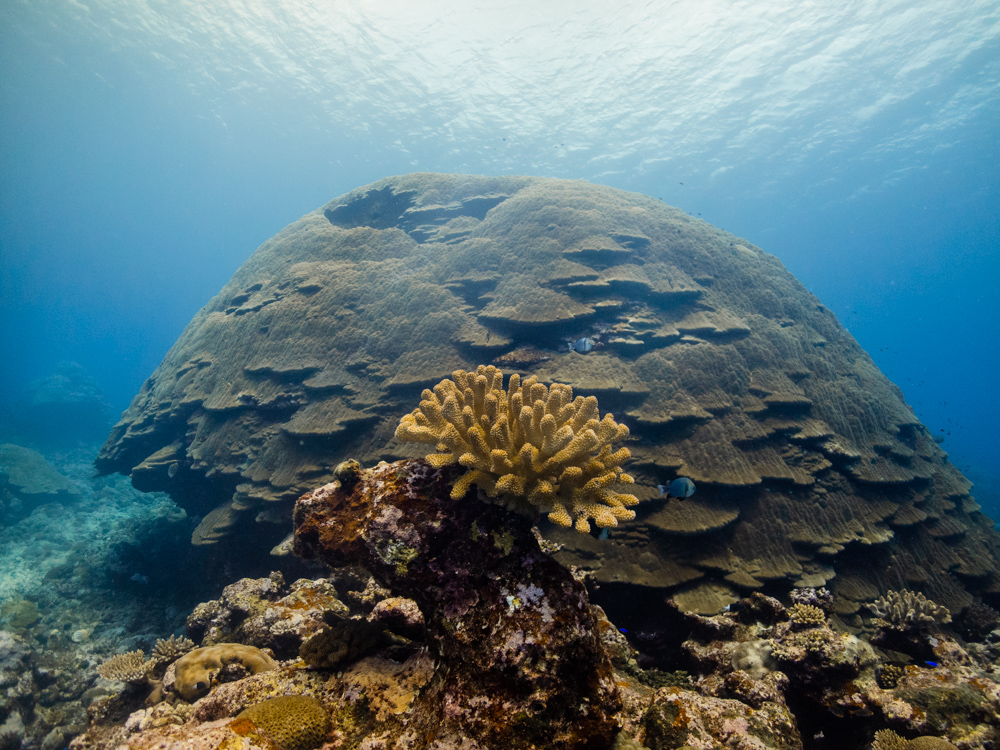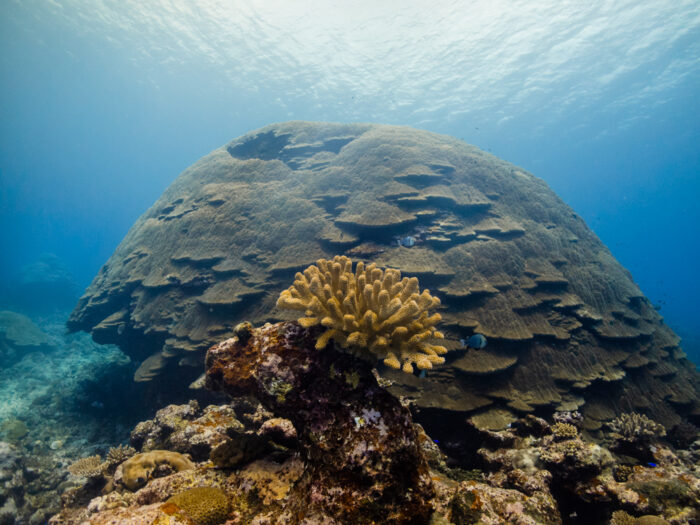
Turning Hope Into Action: An Earth Month Message from Joel R. Johnson, National Marine Sanctuary Foundation President & CEO

Photo credit: Nerelle Que Moffitt
Written by: Joel R. Johnson, President & CEO of the National Marine Sanctuary Foundation
In Fogama’a Bay, a secluded slice of paradise surrounded by three sides by rising sheer black basalt cliffs on the island of Tutuila in American Samoa, a short sandy beach leads to a shallow reef. With the permission of local elders, people can swim with the colorful reef fish over a healthy shallow coral. Little broken pieces of reef will nip at feet in the tide pools while coconut trees and frigate birds sail above head on the breeze. Beyond the wave break, a beautiful underwater landscape unfolds, with hidden caves and valleys all covered in coral and patrolled by large snappers and curious black tip reef sharks. A particularly large coral on the edge of the slope brings to mind its relative, “Big Momma”, a 500-year-old coral measuring more than 19 feet tall and 141 feet around that is located off the island of T’au. These are just a taste of the many ecological wonders in the National Marine Sanctuary of American Samoa.
Last month, NOAA and the International Coral Reef Initiative announced the world is experiencing it’s fourth global coral bleaching event on record, and the second just in the last decade. Heat-stress monitoring by NOAA showed that from February 2023 to April 2024, “significant coral bleaching” was documented in both hemispheres of each major ocean basin, and across the tropics from Florida to the American Samoa in the South Pacific. NOAA’s National Coral Reef Monitoring Program surveyed shallow coral reefs across American Samoa in 2023 and the National Centers for Coastal and Ocean Science funded the first mesophotic coral ecosystem monitoring sites in Fagatele Bay and other sites to assess corals in deeper waters. Last summer, Florida Keys National Marine Sanctuary recorded water temperatures equivalent to a hot tub during the hottest months on human history. It was a clear warning for all our nation’s marine protected areas holding reefs.
Though corals turn bone white as they expel tiny, microscopic algae that give them their dramatic hues and color, they won’t all die from bleaching. Many will recover because they’re deeper or have resilient genetics, a cause for hope. There is hope in paying attention to the tiny things, as the biologist E.O. Wilson was fond of saying. Turning hope into action is exactly where the National Marine Sanctuary Foundation operates, and we believe every Earth Day is a time to renew our commitment to protecting and restoring our waters. Sanctuaries are living laboratories where non-invasive, cutting-edge science is taking place to help us restore nature. Researchers are using observational data and e-DNA to measure the genetic material of organisms in the oceans. Such data could power a forthcoming national strategy on marine biodiversity to shape how we identify new places to protect while building resilience in established ones through restoration. Big Momma and all our iconic coral reefs could stand a chance of surviving.
Throughout Earth Month, the National Marine Sanctuary Foundation is raising our collective voices on Capitol Hill to ensure sanctuaries have the resources they need, including the ability to monitor coral reef health with global satellite technology. This has been instrumental to informing the President’s national goal of protecting, conserving, or restoring at least 30% of U.S. lands and waters by 2030 (30×30). The recently released Conservation Atlas celebrates that approximately one-third of U.S. marine areas are currently conserved, with 26 percent of marine areas conserved in designated Marine Protected Areas, like the 15 national marine sanctuaries. The vast majority of that protected area is actually U.S. waters in the Pacific Ocean in places where corals like Big Momma can thrive. The US Conservation Atlas shows us that we’re merely at the beginning of protecting biodiversity, the richness of life on Earth, and sanctuaries have a role to play. But our coral reefs need investments and funding. Not just datapoints, but people – scientists, researchers, educators, young people, and activists, to lead by voicing their support. The essence of Earth Day’s message is found in the National Marine Sanctuary Foundation’s strength. It lies in the communities who protect our sanctuaries, providing hope and encouraging us all to take action.
We invite you celebrate by considering joining us at Capitol Hill Ocean Week (CHOW) this June as we acknowledge leaders from all walks of life working to protect our oceans, coasts, and Great Lakes; including 2024 Ocean Awards honorees; Brenda Mallory, White House, Council on Environmental Equality; National Geographic Pristine Seas; and Violet Sage-Walker and Fred Collins, Northern Chumash Tribal Council. We’ll also be joined by a diverse group of leaders on the frontlines of a changing climate, including High Talking Chief Atuatasi-Lelei Peau, Superintendent, National Marine Sanctuary of American Samoa, and Sarah Fangman, Superintendent, Florida Keys National Marine Sanctuary to discuss hopeful strategies to protect our corals. To learn more about CHOW and register to attend for free, visit capitolhilloceanweek.org.
